Photos by T.R. Van Devender unless otherwise credited
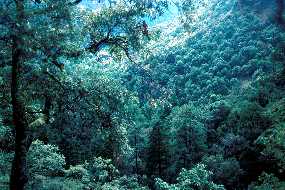
Barranca El Salto (1900 to 2100 m elevation) is a steep canyon on the western edge of Mesa del Campanero west of Yécora in eastern Sonora. The vegetation is a mixed-conifer forest with one of the few stands of Durango fir (Abies durangensis) in Sonora. |
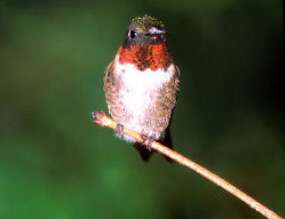
The broad-tailed hummingbird (Selasphorus platycercus) is a long distance migrant that passes through Sonora in montane conifer forest habitats. It’s wing feathers produce a distinctive shrill sound that announces its presence in the forest. Photo: K. Krebbs at ASDM. |
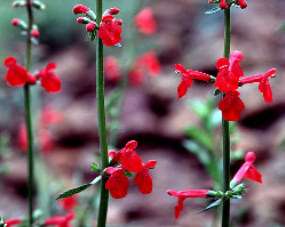
In September 2000 eleven species of hummingbirds were observed in a dense stand of the red-flowered Texas betony (Stachys coccinea) in Barranca El Salto. Photo: Z. Liu |
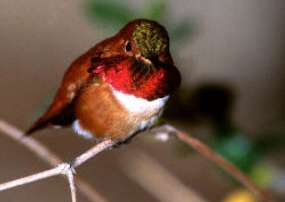
The southward migration of the rufous hummingbird (Selasphorus rufus) in the summer and fall has two distinctive phases. Beginning in July, large numbers of adults including mature males move through western New Mexico and eastern Arizona south through the main Sierra Madre Occidental in Chihuahua. Later in late August through early October, a second wave of rufous hummingbirds, mostly females and young males passes though southern Arizona and eastern Sonora in both lowland and montane habitats. Along the Tónichi-Yécora transect in eastern Sonora, late summer migrants were common in pine-oak forest at El Aguajito and in Barranca El Salto. Photo: K. Krebbs. |
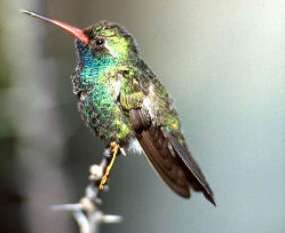
Broad-billed (Cynanthus latirostris, shown here) and Costa’s (Calypte costae) hummingbirds were among the eleven species of hummingbirds observed in Barranca El Salto. The presence of typical lowland species at 1900 m elevation in mixed-conifer forest is very interesting. Apparently, they migrated upward from the tropical deciduous forest to take advantage of the abundant Texas betony (Stachys coccinea) flowers. Photo: J. Flynn at ASDM. |
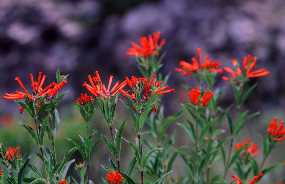
The flora of the Yécora area in eastern Sonora has many brightly-colored flowers that are visited by hummingbirds. Bouvardia or cigarrito (Bouvardia ternifolia) is a small shrub in the Rubiaceae that is common in oak woodland from west Texas to Arizona and south into Mexico. Photos: Z. Liu from near Yécora, Sonora; inset: Mark Dimmitt. |
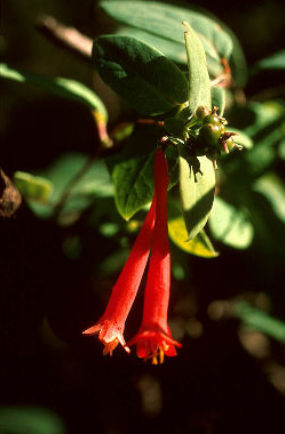
This red-flowered honeysuckle or madreselva (Lonicera pilosa)was seen in the Yécora area only in mixed-conifer forest in Barranca El Salto on the west side of Mesa del Campanero. Photo: G.M. Ferguson from Mesa del Campanero, Sonora. |

Indian paintbrushes (Castilleja spp.) with red or orange bracts and yellow or red flowers are important hummingbird plants in the western United States and northern Mexico. Six species paintbrushes occur in the Yécora area from tropical deciduous forest up to pine-oak forest. The one pictured here (C. patriotica) with orangish bracts is known only from the higher elevations of the Chiricahua and Huachuca mountains in southeastern Arizona and the Sierra Madre Occidental in northern Mexico. On Mesa del Campanero west of Yécora, it forms dense patches in rocky old fields in the pine-oak forest zone. In September, large numbers of southward migrating rufous hummingbirds visit the patches. |
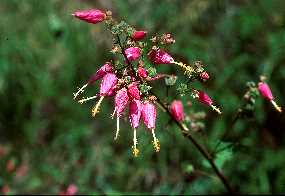
An unusual mallow (Kosteletzkya thurberi) is locally common in the Maycoba area east of Yécora. Its’ rose-colored, hibiscus-like flower makes it worthy of cultivation. |

Most of the morning glory (Ipomoea spp.) vines have purple, blue, or white flowers. Only a few species (I. cristulata and I. quamoclit) have red flowers. The scarlet morning glory (I. cristulata) shown here normally has bright red flowers but is occasionally orange in the Yécora area. |
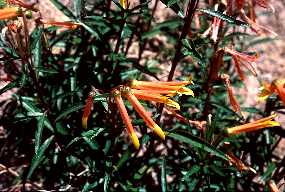 |
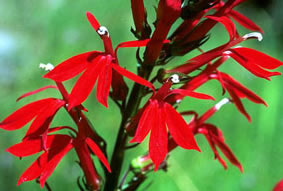 |
| The lobelia (Lobelia laxiflora, above left ) is found in shady wet areas from tropical deciduous forest up to pine-oak forest. The cardinal flower (L. cardinalis, right) with brilliant red flowers is locally common in ciénegas, wet slopes, and stream sides. Both are important hummingbird plants. Photos: Mark Dimmitt; inset: T. R. Van Devender from the Cascada de Basaseachi, Chihuahua. |
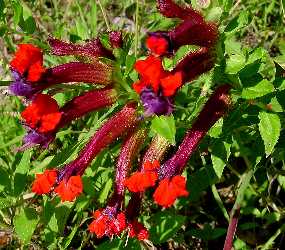
This region is replete with gaudy hummingbird flowers. Bat-faced monkey flower (Cuphea llavea) is among the most brilliant reds of any flower. It is easy to cultivate but is rarely grown. Photos: Mark Dimmitt from near Yécora, Sonora; inset: T.R. Van Devender. |
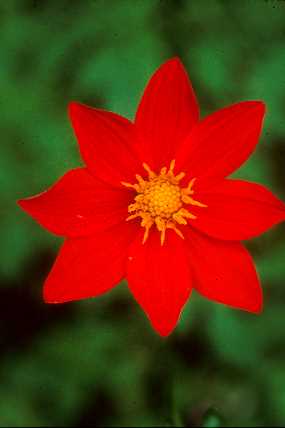
Dahlia coccinea is visited by hummingbirds, though butterflies are probably the main pollinator. |
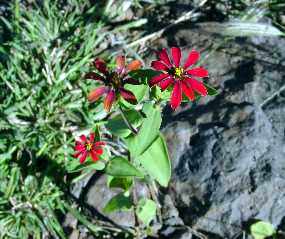
Zinnia peruviana, like the dahlia, is visited by hummingbirds and butterflies alike. Photo: Mark Dimmitt |
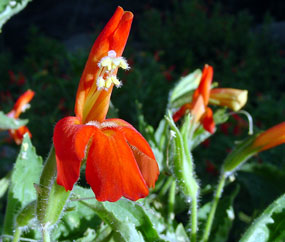
Cardinal monkeyflower (Mimulus cardinalis) is a widespread species, growing almost anywhere there is perennial water. Because it is a wetland plant, it is most common in montane canyons. |
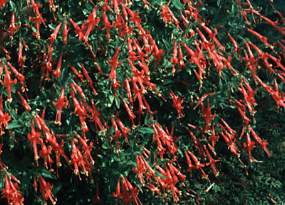
Epilobium canum (Zaushneria californica) grows in wet canyons and flowers in autumn. Photo: Mark Dimmitt |
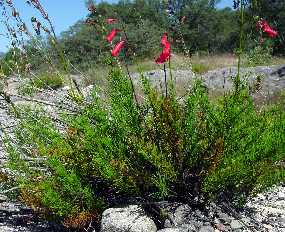
Penstemon pinifolius is known from very few localities. Photo: Mark Dimmitt |
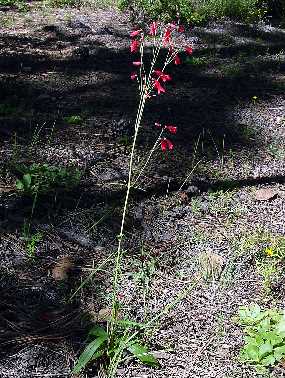
Penstemon wislizeni occurs as widely-scattered plants on Mesa del Campanero. Most hummingbird-visited species are not common enough to be important to the birds, but the plants are largely dependent on the birds for pollination. Photo: Mark Dimmitt |
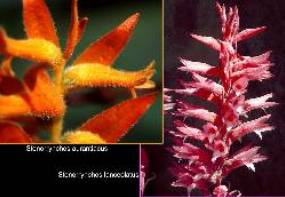
These two terrestrial orchids Stenorrhynchus aurantiacus (orange) and S. lanceolatus (pink) are probably hummingbird-pollinated. Photos: T.R. Van Devender (left) and Mark Dimmitt |
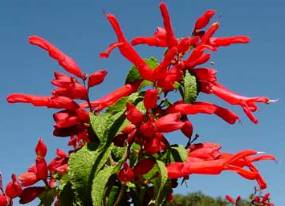
The Maycoba sage (Salvia betulaefolia) with its spectacular displays of red flowers in September in oak woodland near Maycoba is worthy of cultivation. Photo: Mark Dimmitt |
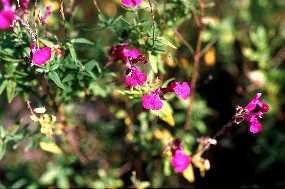
Salvia microphylla is a subshrubby sage with magenta flowers that is common in pine-oak forest on Mesa del Campanero. |